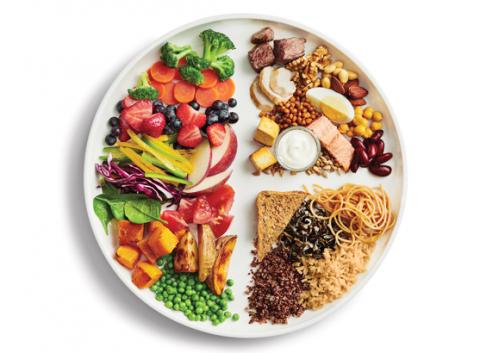
In September, Ophea hosted two webinars (one in English and one in French) to introduce Canada’s new food guide to educators; through identifying connections to the 2019 Health and Physical Education (H&PE) elementary curriculum and exploring teaching strategies for different grade levels.
We would like to thank The Helderleigh Foundation for their partnership on this webinar, as well as our co-presenters:
- Cara Rosenbloom RD is a dietitian and founder of Words to Eat By. She is a columnist for the Washington Post and Today’s Parent, and co-authored the books Nourish and Food to Grow On.
- Robin MacDonald is an Ambassador for Ophea, and a Specialist Health and Physical Education and Special Education teacher with the Near North District School Board.
After an overview of the history and new design of Canada’s food guide, webinar participants had the opportunity to share their teaching ideas with one another, exploring how they can make the guide come to life in the classroom. Thank you to all of the participants who shared their creative and unique ideas!
View the full webinar on our YouTube channel and read the overview below.
History of the Food Guide
There’s been a food guidance document for Canadians since 1942, when the first guide was introduced during wartime rationing to help prevent nutritional deficiencies. While the guides have had different forms over the years, the core concept remained the same: food guides are basic education tools that are designed to help people learn how to eat well.
The guide is used to plan meals for daycares, hospitals, retirement centres, and long-term care facilities, and is part of the 2019 H&PE elementary curriculum too. As a result, it’s important for all Canadians.
The current food guide takes a different approach for the first time since 1942. Instead of one static document, the guide is now an online resource, featuring the prominent “Eat Well Plate” as well as videos, recipes, tips, and resources that explore far beyond this image of “what to eat.”
It was the right time for an update, too. The new guide is based on up-to-date science and has no industry-driven bias or influence. It has a simple premise and is easier to use than previous guides. For the full food guide experience, visit the Canada food guide website.
What’s new?
The food guide website was launched in January 2019, and includes a range of helpful information, resources, and tools that can help educators teach students about healthy eating. The online experience is partially summarized into a two-page document called the Food Guide Snapshot. The front of this two-page snapshot is the Eat Well Plate showing WHAT to eat, and the back includes boxes with advice on HOW to eat. You can print a PDF of the two-page snapshot and/or you can order print copies. It’s available in over 30 different languages, including many indigenous languages.
The “what to eat” section of the guide shows a plate that’s divided into quadrants. The advice is to:
- Fill half your plate with vegetables and fruit
- Fill a quarter of the plate with whole grains, such as brown rice, whole grain wheat or quinoa
- Fill a quarter of the plate with protein foods, emphasizing plant-based options such as tofu, chickpeas and beans
- Make water the drink of choice
The “how to eat” section offers advice such as:
- Be mindful of your eating habits
- Eat meals with others
- Cook more often
- Use food labels
- Be aware of food marketing
- Limit foods high in sodium, sugars and saturated fat
- Be aware of how food choices affect the environment
The overall advice differs from the old food guide, which had a narrow focus on “what” to eat. This new guide recognizes that there’s so much more to explore about where, how, and why we eat. This approach also provides many more teaching and learning opportunities!
Building the food guide into the curriculum
The guide connects to the 2019 Health and Physical Education elementary curriculum, but teachers can use broad strokes and incorporate food guide messaging into language, math, science, art, music, drama, French, social studies and more. Here are just some of the creative ideas shared by our webinar participants:
- Have students make fruit kebobs to incorporate numeracy skills like patterning and counting in the primary grades
- Learn about nutritious foods from other cultures or time periods to reflect social studies learning – make a class cookbook, or host a healthy eating showcase where students can try new foods
- Create a health focused alternative menu for a community centre or movie theatre as a health promotion piece
- Write a persuasive essay on the benefits of healthy eating or create recipes for procedural writing
- Create a personal Eat Well Plate using magazine cut outs, drawings, or computer design. Incorporate numeracy by evaluating nutrient densities or look at the plate as a pie chart!
- Incorporate media literacy by evaluating food ads; make your own ads or product mock-ups
- Examine ecology principles by talking about food waste and environmental sustainability
Here’s a list of resources that can help you teach Canada’s food guide:
- Canada’s Food Guide
- Ophea’s Healthy Eating Lesson Plans
- Healthy Schools Certification: Healthy Eating
- BrightBites (Ontario Dietitians in Public Health)
- Freggie Tales (Canadian Produce Marketing Association)
- Unlock Food (Dietitians of Canada)
- Nutrition Connections (Ontario Public Health Association)
Let’s keep the conversation going! Share with us on Twitter @OpheaCanada and on Facebook what other ideas you have for connecting to Canada’s new food guide within your teaching and also let us know what other information you need to support you.
To stay up-to-date on how Ophea is supporting H&PE curriculum implementation and integrating Canada’s food guide into your classroom and school lessons and activities sign up for Ophea’s e-newsletter eConnection.
